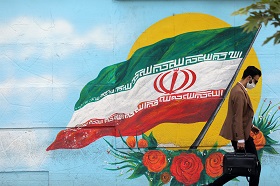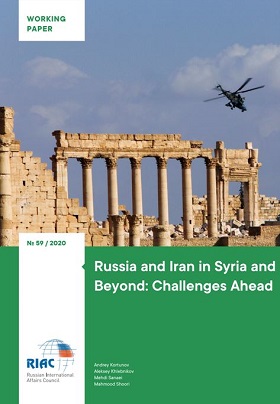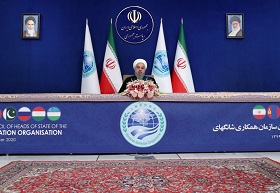Negotiations on a full-scale free trade agreement between Iran and the Eurasian Economic Union
(EAEU) are planned for the second half of 2021. The success of the current interim agreement with
Iran suggests that initiating a proper FTA could indeed work. However, a number of obstacles—which
have nothing to do with customs duties and trade tariffs—need to be eliminated if any possible
agreement is to bear fruit. Being the parties most interested in reaching such an agreement, Iran and
Russia remain the main drivers of Iran’s rapprochement with the EAEU.
Negotiations on a full-scale free trade agreement between Iran and the Eurasian Economic Union (EAEU) are planned for the second half of 2021. The success of the current interim agreement with Iran suggests that initiating a proper FTA could indeed work. However, a number of obstacles—which have nothing to do with customs duties and trade tariffs—need to be eliminated if any possible agreement is to bear fruit. Being the parties most interested in reaching such an agreement, Iran and Russia remain the main drivers of Iran’s rapprochement with the EAEU.
A Full-Scale Agreement
Signing a full-scale free-trade agreement with Iran was hardly surprising, given the previous agreements between the EAEU and Tehran. On May 17, 2018, Iran put pen to paper on a three-year interim agreement on the establishment of a free trade area (FTA) that entered into force on October 27, 2019. Among other things, the parties agreed to launch talks on making the interim agreement permanent (with changes) no later than 18 months after it would come into effect, as well as to conclude such talks within three years of that same date.
Everything that the parties have said and done in this respect has been in accordance with the previous agreements. The decision to launch negotiations with Iran was made on December 11, 2020, and the first consultations took place on February 17, 2021, that is, somewhat less than 16 months after the FTA agreement entered into force.
Assuming everything goes to plan, the issue of a full-scale agreement should be settled before October 27, 2021. To this end, more comprehensive negotiations have been pencilled in for the second half of this year. In any case, the sides still have over a year to resolve any issues that may come up, as Minister of Energy of Iran Reza Ardakanian duly noted in early March when he said, “We’ve got some one and a half years to put things in place.” [1]
In other words, a full-scale free-trade agreement between Iran and the EAEU may not necessarily be concluded by the end of this year. Judging by what both Iran and the EAEU member states say, all the sides are interested in replacing the interim agreement with a permanent one. However, a new round of talks will surely focus on expanding the range of goods and reducing the duties even further. The parties will try to protect the interests of their domestic producers as much as possible, and it will hardly be surprising if they fail to reach a consensus straight away so that everything eventually drags out.
There is another factor that might prove a serious obstacle to cooperation between the EAEU and Iran, which is the EAEU’s ongoing FTA negotiations with Israel. The Israeli Ambassador to Russia has noted that such an agreement could be signed as early as this year. Iran has yet to comment on the matter. However, should Tel Aviv and the EAEU manage to reach agreement, there are forces within the Iranian political system that are capable of stirring up a wave of discontent, which could scupper all diplomatic efforts invested to achieve a full-scale FTA.
The rumour that Iran could be about to join the EAEU added a new dimension to this story. Tongues started wagging following the comments made by Mohammad Bagher Ghalibaf, the Speaker of Iran’s Parliament, after his trip to Moscow on February 10, 2021, which many interpreted as Tehran announcing its intentions to become a full-fledged member of the Union. A number of Russian and English publications ran with the story, discussing the prospects of such a move.
However, the Ministry of Trade and Integration of the Republic of Kazakhstan would later deny these rumours. There are certain procedures that must be followed to become a member of the EAEU, including that of submitting an application to the Chairman of the Supreme Eurasian Economic Council. “As of February 17, 2021,” the Ministry’s statement reads, “the relevant application has not been received from the Islamic Republic of Iran.”
A Pivot to the East
The very notion of rapprochement between Iran and the EAEU fits comfortably into Tehran’s strategy of pivoting to Asia and its markets. The move started to take shape back in the 2000s and was mainly motivated by economic trends, namely, the growing need in energy resources of the rapidly developing Asian economies, such as China and India. Then sanctions followed, and following the US withdrawal from the nuclear deal in May 2018 the pressure has considerably increased. All this made the Iranian elites to become disenchanted with the idea of fostering economic ties with Europe, as businesses in the EU turned out to be most sensitive to the restrictions imposed by Washington.
It would seem that cooperation with the EAEU avails Iran an opportunity to mitigate the effects of the U.S. sanctions policy. The fact that several EAEU countries are under Western sanctions certainly helps in this respect. On February 7, 2021, Roman Golovchenko, Prime Minister of Belarus, argued that the EAEU is looking to develop a mechanism for countering sanctions to give cause for optimism.
What is more, Iran is interested in abandoning the U.S. dollar in settlements and switching to national currencies. This remedy acquired even greater urgency once Iran was cut off from the SWIFT international settlement system as a result of U.S. pressure. The EAEU has repeatedly stated that it is consistently moving towards this goal. Similar comments and practices are evident in bilateral relations between individual EAEU member states and Iran.
Finally, Tehran is trying to break out of its political isolation. Rapprochement with the EAEU could thus help elevate its status on the international stage. On the whole, establishing the interim FTA with its subsequent transformation into a full-scale agreement should be viewed in the broader context of Iran’s striving to strengthen regionalism and bolster Eurasian cooperation.
As far as the EAEU interests are concerned, one should say that Iran represents serious potential for the Union’s expansion. Among the economies of the EAEU member states, observers and partners, the Iranian economy is second only to Russia’s. In terms of economic cooperation, Russia and Kazakhstan stand to benefit most from lowering tariff barriers. In addition, the project is of particular interest to Armenia, which is the only EAEU member that has a land border with Iran—currently under a partial blockade. Armenia could thus be used as a transit country for Iranian imports and exports. A free-trade agreement with Tehran would also do wonders for Moscow’s integration policy.
FTA Experience
The interim agreement on establishing a free trade area between the EAEU and Iran entered into force on October 27, 2019 and provided for a reduction in customs duties on 862 categories of goods (502 for Iranian exports and 360 for EAEU exports). The list of goods covers approximately 50% of the total mutual trade between the partners. The agreement came into effect amid a difficult time in Iran, owing to the U.S. sanctions regime and the coronavirus lockdown. Despite this, however, trade turnover between the EAEU and Iran grew to $2.9 billion in 2020, an 18% increase from 2019.
At the same time, as far as EAEU exports are concerned, we rather stand witness to their recovery to the level prior to the restoration of U.S. sanctions. It was immediately after the nuclear deal became effective and the sanctions against Iran were lifted in 2016 that exports hit a recent-year record high at $2.6 billion. While EAEU 2020 exports rose by 2% as compared to 2019, they only amounted to $1.6 billion.
A somewhat different situation could be observed in the case of EAEU imports from Iran in 2020, which grew by 51.5% as compared to 2019, surpassing $1.2 billion. This is significant, as for the previous ten years imports had not exceeded $1 billion. In other words, the Iranian economy benefited significantly more from the establishment of the FTA than the EAEU, at least during the initial stages of the deal. What is more, this had to do with non-oil sectors of Iran’s economy, as EAEU imports are primarily based on agricultural products.
At the same time, Iran occupies a relatively insignificant place in the trade balance of the EAEU countries, accounting for just 0.5% of all trade operations in the Union. Meanwhile, the EAEU countries account for approximately 3% of Iran’s trade balance.
We should also note the uneven distribution of trade between the individual EAEU countries and Iran. For example, Russia accounts for approximately 75% of all trade between the EAEU and Iran, which is around 85% of exports and 65% of imports. Kazakhstan accumulates some 10% of the total trade turnover, with its trade volume shrinking by 37% in 2020, as opposed to the trade with the EAEU as a whole. Meanwhile, the share of Belarus and Kyrgyzstan is almost next to nothing.
Relations between Tehran and Yerevan are somewhat different. Armenia makes up approximately 15% of all trade with the EAEU. Additionally, more than 25% of all EAEU imports from Iran go to Armenia. Armenia is thus a valuable partner for Iran, purchasing food and industrial products, as well as oil and gas from the country. These special relations are reflected in the fact that Iran makes up almost 9% of Armenia’s trade turnover.
Definite changes were recorded in the dynamics of trade relations following the conclusion of the interim FTA agreement. In the case of Russia, both exports and imports increased (by 19% and 100%, respectively). Meanwhile, Iran’s trade with Belarus and Kyrgyzstan remained negligible. In the case of Armenia, slight changes have taken place, with exports increasing by 1% and imports falling by 3%. Exports from Kazakhstan have dropped by 54%, while imports have increased by 32%.
In other words, the FTA serves as an incentive for Russia to foster trade with Iran. Kazakhstan has also increased its imports from the country. However, there have been no serious positive shifts with regard to the remaining EAEU countries.
Real Prospects
It would seem that trade cooperation between Iran and the EAEU will do little to alter the economic situation for its participants. For Tehran, however, the EAEU can serve as a reliable partner with stable trade ties, something that is of particular importance to a country suffering partial economic isolation. Meanwhile, Moscow—still the key driver for cultivating economic relations with Iran—sees Tehran as a potential buyer of its industrial goods. This is especially important given the fact that hydrocarbons remain at the heart of Russia’s exports around the world. Finally, as we mentioned earlier, Iran can play a special role in the development of the Armenian economy.
Expanding the FTA agreement to include additional product lines may serve as a basis for bringing the economic relations between the parties to a new level. However, a number of barriers that have nothing to with customs duties and trade tariffs still pose a major problem for the development of trade between Iran and the EAEU. On the one hand, there are objective limitations that will hardly be eliminated in the foreseeable future. For example, trade opportunities are limited by the fact that the oil sector remains the backbone of the economies of Iran, Russia and Kazakhstan. This is why the EAEU cannot offer Iran anything comparable to what China offers. Then, there is the special position that Russia occupies on the EAEU energy markets. Tehran can hardly expect to significantly increase its gas supplies to Armenia, as Russia continues to have a hold on this market. Finally, U.S. sanctions play a huge role in limiting development opportunities, and the EAEU and Iran can only partially neutralize their negative effects.
At the same time, the parties are in a position to work on removing other equally important obstacles, for example, developing a transport and logistics infrastructure and automating and digitalizing customs procedures in order to avoid delays and red tape at the borders. Receiving payment for goods remains a big problem after Iran was cut off from the SWIFT system. Much work has already been done to transition to settlements in national currencies, although it is far from complete. What is more, Iran is not a member of the WTO, and its business practices do not meet international standards in most cases.
We should also mention the specifics of doing business in Iran, which presents additional challenges when it comes to concluding and implementing agreements with foreign partners. Iran’s economic isolation and unpredictable foreign policy environment are the core reasons why it keeps such business practices. Increasing its foreign economic activity, including that with the EAEU countries, should help Iranian businesses get to grips with working under the rules that have been adopted in international trade.
In other words, a full-scale agreement between Iran and the EAEU has great development prospects. However, real prospects primarily depend on the ability of both governments and businesses to work to remove those barriers that are not connected with customs duties and trade tariffs.
1. Minister: Iran Still Has Around a Year and a Half to Become a Permanent Member of the EAEU, RIA Novosti, March 4, 2021.







